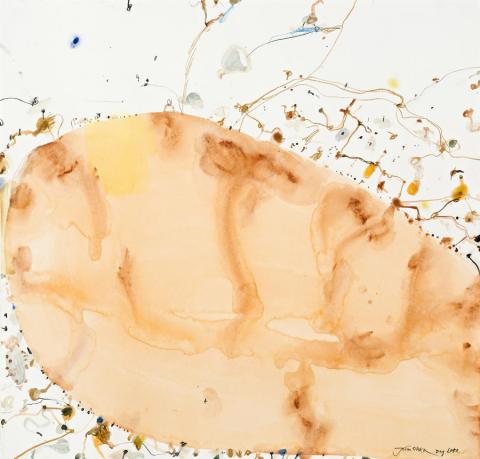DRY LAKE, 1995
John Olsen
watercolour and mixed media on paper
95.0 x 100.0 cm
signed and inscribed lower right: John Olsen Dry Lake
Deutscher~Menzies, Melbourne, 3 May 2000, lot 68
Australian Art Investment Trust (label attached verso)
Private collection, Melbourne
For Olsen, the lake shaped like Salvador Dali's bent watch was a place of contradictions, of life and death, fullness and emptiness. Here he could celebrate the 'festival of life' in the myriads of creatures in and around the lake, and direct his vital, calligraphic lines into the long, pulsating channels and rivers which travelled through hundreds of kilometers of desert towards Lake Eyre. Life approached the lake, clinging to its edges; however, the lake itself was a place for contemplation, a vast, engulfing space: the void.
The concepts of 'the void' and 'the edge' were of seminal importance to the development of Olsen's work during this period: to the serene atmosphere and reductive qualities found in many of his works, where the empty spaces are as important as the marks themselves, and to the line probing space, becoming the edge, where things meet, end and begin again.
Olsen's notion of the void did not imply a negative response to the interior but related instead to the paradoxical nature of the full and empty lake, the 'ocean' and the desert which, in turn, found a direct correspondence with his interest in Oriental philosophy. On the one hand, when he stood at the edge of the full lake there was an overwhelming feeling of space and light, of 'inviting silences' and a sense of 'complete emptiness'...
On another level, Olsen recognised that the full lake was inextricably 'entwined with the eternal destiny of the empty lake, with its deceptive mirages and blinding salt deposits, to which it would inevitably return; the same arid landscape which had come to wide public attention when the British speed ace, Donald Campbell, broke the world land-speed record there in 1964...'1
1. Hart, D., John Olsen, Craftsman House, Sydney, 1991, pp. 133-134
